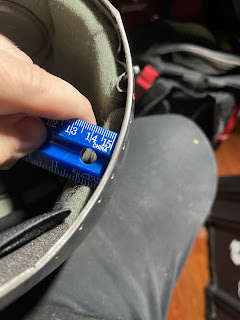SCA 14th Century Bascinet Helmet Padding
Recently I posted a picture online, which caused a few caring people to reach out to me in regards to my helmet padding (pictured below):
This concern led me to triple check my padded, which was high quality EVA foam in thicknesses of 1/4" by my ears, 1/2"along the lower back, and 5/8" around the brow band and 1" at the center top of the helmet. Using a basic ruler I checked the latest version of the Midrealm Marshall's Armored Combat Handbook to confirm I was within regulations. Per the handbook it requires that the parts of the helmet in contact with my head be padded with a minimum of 0.5 inch (12.7mm) of closed-cell foam or equivalent padding (Full regulations on padded as of 02 July, 2021 listed in green italics below).All parts of the helm that might cause injurious contact with the wearer's head shall be padded with a minimum of .5 inch (12.7 mm) of closed-cell foam or equivalent padding, or shall be suspended in such a way as to prevent contact with the wearer during combat. Similarly, parts of the inside of the helm that might come in contact with the wearer's neck or body should be padded. All helms shall be equipped with a chin strap or equivalent means to prevent the helm from being dislodged or metal contacting the wearer's face during combat. A "snug fit" is NOT equivalent. The chin strap shall be, at a minimum, .5 inch (12.7 mm) in width and shall not be placed in the helm in a manner that could strangle the wearer. Midrealm Rule: Minimum helmet padding and construction requirements must be present in the helm at the time of inspection every time the helm is inspected. Padding that has degraded over time fails inspection, regardless of whether it was legal when first installed in the helmet.
After looking everything over in my helmet, I met the minimum requirements outlined, but to be honest, I wasn't as confident in the padding as I should be. It was then that I remembered that I have an unused Team Wendy Search and Rescue Helmet with their upgraded Epic Helmet lining pads (which can be purchased separately from the helmet for approximately $80 online: https://www.teamwendy.com/products/aftermarket-systems/liner-systems/epic-combat-helmet-liner-system for more information). As I no longer use this helmet for work anymore and it was sitting around in practically brand new condition, I pulled the padding from it and went to work.
Using the Team Wendy padding as my base, I was able to get a better fitment out of the helmet, bring it down slightly more onto my head, and nest my whole head further back in the helmet. It took me several times of placing padding (I use duct tape temporarily, then used adhesive velcro strips once placement was determined) and trying it on, to figure out the whole comfort level. If you aren't confident in your ability to do this, most Marshall's, Knights or experienced fighters should be able to help you pad your helmet. This is not something to skimp on as you only have one head and traumatic brain injuries are nothing to play around with. If anyone recommends blue camp pad foam, run away and find help elsewhere. There are several videos available on Youtube which better discuss helmet padding, so I'm not going to dive in that, but rather just capture what mine looks like below:











Comments
Post a Comment